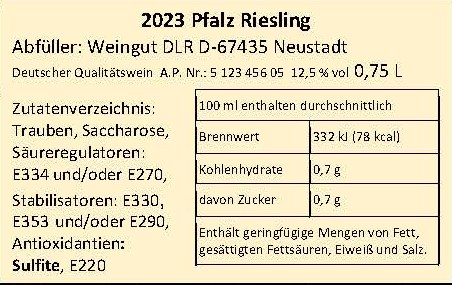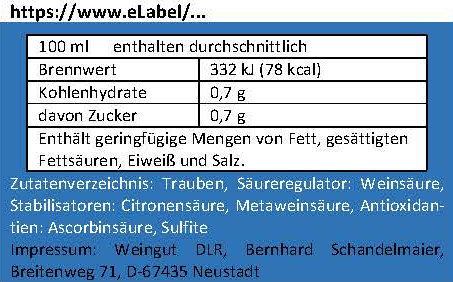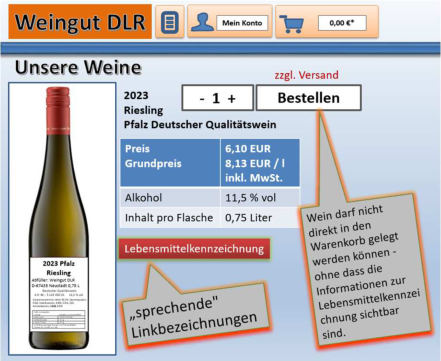From 8 December 2023, all wine labels must show detailed information on nutritional values, additives and allergens. However, the labelling obligation does not only apply to bottles, but also to price lists, online shops and other forms of ordering. We have compiled the most important details.
It has been announced for a long time, now it will become concrete: At the end of 2023, wines, sparkling wines, fruit wines and aromatised wines will be treated like food according to EU law. This means that they must be provided with a list of nutritional values and ingredients. Currently (as of June 2023), however, European wine associations are still negotiating with EU officials to exempt all wines produced before 8 December 2023 but not yet labelled from the labelling requirement. Should the EU officials give in, almost the entire 2023 vintage would not (yet) be affected. It is not yet clear when the final decision will be made - and with what outcome.
Whether with vintage 2023 or 2024: Every producer has the choice to list the information directly on the label or to make it available online with a QR code. The only exceptions are the information on the nutritional value in kilocalories and kilojoules and the allergenic substances. Both must be read directly on the label.
.jpg)
In this form, in the future QR code and nutritional information must be displayed on the label.
DLR NeustadtFor the information on the label, a tabular form is prescribed in which the information refers to 100 ml. .
With an "e-label" (QR code), the complete nutrition declaration and list of ingredients can also be indicated digitally. However, calorific value information and allergen labelling must be read directly on the wine label despite the QR code. In the case of an e-label, the allergen labelling can also be provided outside the field of vision of the mandatory information.
The language used for the list of ingredients and also the nutrition labelling must be easily understandable for the consumer of the country of marketing, i.e. in the national language(s).
The nutrition declaration includes information on calorific value, fat, saturated fatty acids, carbohydrates, sugar, protein and salt. The calorific value in kilojoules (kJ) and kilocalories (kcal) must be declared on the label, at the notice for the quality wine test number. For carbohydrates and sugars, it is recommended to indicate the value based on the residual sugar content of the wine.

If no QR code is used, this information must be found on the label from the 2023 or 2024 vintage.
DLR NeustadtFat, saturated fatty acids, protein and salt are contained in wine in negligible amounts due to technological reasons. Therefore, a current analysis of these values is usually not necessary. If they are contained in negligible amounts, the contents must be indicated in grams (g). The declaration of the calorific value in kJ and kcal as well as of the carbohydrates and sugars above 10 g per 100 ml is done without decimal place. Values below 10 g per 100 ml are indicated to the nearest 0.1 g, and table salt is indicated to the nearest 0.01 g.
Alternatively, the statement "Contains minor amounts of fat, saturated fatty acids, protein and salt" can be given below the table.
In addition to the nutritional values, all ingredients that are necessary for the production of a wine and are not completely consumed or removed (processing aids) must also be listed. The list of ingredients must be introduced with the word "Ingredients:" followed by the list of ingredients used in descending order of quantity (mass). The official designations or, if available, E-numbers must be used. In addition, the additive class for each additive shall be indicated.
The list of ingredients always starts with the term "grapes" or "grape must" (if not already dealt with). In the case of fortification, the term "sugar" usually follows. If several wines have been blended, it is advisable to list all the ingredients used together. Sugar, tartaric acid or sulphur dioxide are thus only listed once in the list. Ingredients that make up less than two percent of the final product can be listed at the end in any order. This applies to many additives and treatment agents - they must be included in the list
Allergens must be correctly named and highlighted in the list of ingredients, usually in bold. For example, the allergens are indicated like this: "sulphur dioxide" or "E220 (sulphites)", "potassium bisulphite", "potassium metabisulphite", "lysozyme (egg)", "egg albumin", "casein (milk)". The latter may also be listed as a processing aid under certain circumstances. But be careful: if the list of ingredients is explicitly stated on the label, the mere indication of "sulphites" does not satisfy the legal EU labelling requirements. If a QR code is used on the label, the statement "Contains sulphites" must also appear on the label.
The labelling must be clearly legible, indelible and stand out from the background. The minimum font size for labels is 1.2 mm x-height, where the x-height is the height of the lower case "x" measured from the baseline. All information must be in the same field of vision as the other mandatory information (alcoholic strength, nominal volume, bottler, etc.). If the list of ingredients and the nutrition table are placed next to each other, the approximate space required on the label of a 0.75 l bottle is 6.8 cm in width and 2.5 cm in height.
With the exception of the calorific value (kJ, kcal) and the allergen labelling (as a rule "contains sulphites"), the new labelling elements may be indicated online via the link to the QR code on the label. But there are three conditions:

Example of DLR Neustadt for a list of ingredients online, which appears after clicking on the QR code.
DLR NeustadtThere is no minimum size for the QR code. To be easily readable, QR codes generally need a size of at least 1 x 1 cm.
The information must be given in accordance with the harmonised tolerances in the EU. For wines with less than 100 g/l sugar, i.e. almost all wines except noble sweet wines, a tolerance of 2 g/100 ml is allowed (equivalent to 20 g/l). For noble sweet wines with more than 100 g/l sugar, the EU tolerates deviations of up to 20 percent in the carbohydrate/sugar declaration.
There is no EU-wide harmonised tolerance for the calorific value. However, deviations may occur due to individual tolerances for alcohol content, residual sugar and acidity. Therefore, "a certain range of variation" is also accepted for the declaration of the calorific value. How large it will be is not yet known.

In online shops, the link to the list of ingredients must be clearly visible for each wine.
DLR NeustadtOn price lists, brochures, flyers as well as in web shops, which allow direct ordering of wines by end consumers online, by letter, telephone or fax, the list of ingredients and nutritional information must also be indicated. Here it is important that the customer has access to all relevant labelling information during the ordering process. If there is not enough space for a tabular presentation of the nutritional values, in exceptional cases the nutritional values can also be listed one after the other - as long as legibility is ensured.
Wine marketers who sell their bottles to end consumers must also adapt their wine labels, price lists and web shops accordingly. Many winegrowers' associations have made special agreements with digital label providers and recommend their members to prepare for the implementation of the new regulations at an early stage.